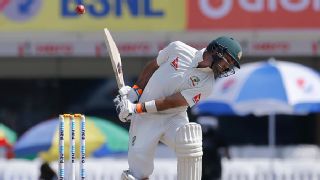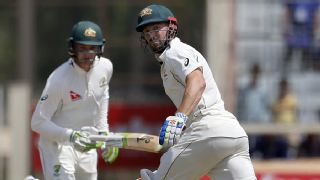9Steven Smith (four matches, 499 runs at 71.28) If there was one key difference between Australia's tours of India in 2013 and 2017, it was Smith. In 2013, Smith came in only for the final two Tests and showed with 92 in Mohali that he had the ability to thrive in spinning conditions. Four years later, he is the best batsman in the world, and was the key to Australia's chances of an upset series win. His remarkable second-innings hundred in the first Test in Pune - among Australians, only Mark Taylor and Damien Martyn had previously made second-innings centuries in India - set up Australia's big win. Hundreds in Ranchi and Dharamsala gave Australia hope in both Tests, and he joined Everton Weekes, Ken Barrington, Alastair Cook, Gary Sobers and Hashim Amla as the only visiting players to score three Test tons in a series in India. Smith finished the series as the leading run scorer from either side, with 499 at 71.28. At the end of the 2013 tour, he was yet to score his maiden Test hundred. Four years later, he has made 20. What a difference four years makes - to Smith, and to Australia. 8Steve O'Keefe (four matches, 19 wickets at 23.26) Whatever else O'Keefe's career holds for him, he will always be the man who bowled Australia to their first Test win in India for 13 years. In each innings of the Pune Test, O'Keefe picked up 6 for 35, which left him with match figures of 12 for 70 - only Ian Botham among visiting bowlers had ever achieved better match figures in India. O'Keefe turned the match with a stunning first-innings spell in which he took all six of his wickets in 24 balls - including three in an over. He found the right length and used his natural variation to flummox some of the world's finest players of spin. Only seven further wickets came in the series, but his tally of 19 at 23.26 still ensured he sat equal top of Australia's wicket list alongside Nathan Lyon. Nathan Lyon (four matches, 19 wickets at 25.26) Like O'Keefe, Lyon finished the series with 19 wickets, in his case at 25.26. He bowled well in Pune, though O'Keefe gained the greater rewards. But in the first innings of the second Test in Bengaluru, it was Lyon who sliced through India. He finished the innings with 8 for 50 - the best figures by any visiting bowler in a Test in India. Like most of the Australians, he had a tough time of it in Ranchi, but another five-wicket haul came in Dharamsala. Both Lyon and O'Keefe can be proud of their efforts against high quality players of spin.  7Matt Renshaw (four matches, 232 runs at 29.00) His raw figures - 232 runs at 29.00 - may not look like much, but Renshaw was one of the shining lights in Australia's batting order in this series. Although he had finished the home summer with a hundred against Pakistan at the SCG, his lack of experience overseas and against quality spin left him uncertain of his place for the first Test. In the end, he was picked and immediately showed why. In the first innings of the series, Renshaw top scored with a patient 68 that helped set up Australia's win, and he followed it with a 60 in the first innings in Bengaluru. For a 20-year-old, these were impressively unflustered performances, and Smith said Australia's senior batsmen had learnt a thing or two from the younger man. Renshaw finished the series behind only Cheteshwar Pujara, Smith and KL Rahul for balls faced - a fine outcome that augurs well for his future. Glenn Maxwell (two matches, 159 runs at 39.75) In his three previous Tests, Maxwell had been used in all sorts of strange ways by Australia, from batting at No.8 as a specialist spinner, to opening the batting and bowling, to coming in at first drop. Here, he finally got the chance to fill the role to which he is most suited: batting at No.6 and bowling the occasional over. And when he got his chance in the third Test in Ranchi, he responded brilliantly, with a mature 104 as part of a hefty partnership with Smith. A counter-attacking effort in the second innings in Dharamsala threatened to set India a competitive target, until he was lbw for 45. His fielding was also outstanding, and the question now is whether he will finally end Australia's trend of churning through men at No.6 and make the position his own. 6Pat Cummins (two matches, eight wickets at 30.25) Three weeks ago, Cummins was just trying to get through a Sheffield Shield game - his first for nearly six years due to his ongoing injury struggles. He did so brilliantly, and Australia's selectors took the gamble to rush him to India mid-series to replace the injured Mitchell Starc. Cummins immediately made an impact, with four wickets in trying conditions in Ranchi, and he backed it up with four more in Dharamsala. He bowled with impressive speed and always looked dangerous. Most pleasingly for Australian cricket, he came through the two Tests apparently unscathed. The prospect of Cummins, Starc, Josh Hazlewood and James Pattinson all being fit and available for next summer's home Ashes series is an exciting one. Josh Hazlewood (four matches, nine wickets at 32.77) Hazlewood toiled hard throughout the series and was generally economical, but in only one innings was he truly rewarded for his work. His 6 for 67 in the second innings in Bengaluru kept Australia in the game and allowed them to chase a sub-200 total - that the batsmen were unable to get close on a deteriorating surface was no fault of Hazlewood. He finished the series with nine wickets at 32.77, and was the only Australian fast bowler to play the entire series.  Mitchell Starc (two matches, five wickets at 30.20, 118 runs at 29.50) Although Starc had to fly home at the halfway point of the series due to a stress fracture in the foot, his contribution to the win in Pune should not be forgotten. In India's first innings, Starc claimed the key wickets of Pujara and Virat Kohli, both cheaply and within the space of one over, to set up India's collapse. His batting in that Test, particularly his 61 in the first innings, was also significant. Again in Bengaluru, Starc showed how he can change the course of an innings - his wickets of Ajinkya Rahane and Karun Nair off consecutive balls sparked India's lower-order collapse in the second innings. Matthew Wade (four matches, 196 runs at 32.66, nine catches, four stumpings) There was some consternation when Wade replaced Peter Nevill in Australia's Test team during the home summer, particularly with an Indian tour on the horizon. But Australia's selectors were adamant that Wade's glovework had improved. Indeed, throughout this series he missed few opportunities, although his drop of Wriddhiman Saha off O'Keefe in Ranchi was costly - Saha was on 51 at the time and went on to make 117. With the bat, Wade made useful contributions and finished with 196 runs at 32.66. His only fifty came in the first innings in Dharamsala and he remained not-out in the second when he was disciplined but perhaps could have gone a touch harder to set India a tougher target. Still, Wade was far from a passenger on this tour. 5Peter Handscomb (four matches, 198 runs at 28.28) In many ways this was a frustrating series for Handscomb. He made a start in almost every innings - 22, 19, 16, 24, 19, 72*, 8 and 18 - but as those scores show, he was unable to turn any of them into a hundred. The stand-out score in that list, the unbeaten 72, was significant, for it came in the second innings in Ranchi and was key to Australia batting out a draw and keeping their hopes of a series win alive. So impressed was Smith with Handscomb's innings that he said it was "worth 150 in my eyes". Shaun Marsh (four matches, 151 runs at 18.87) The inclusion of Shaun Marsh for this series was not without controversy, and his final tally of 151 runs at 18.87 can hardly be viewed as a success. And yet to really assess Marsh's value in this series, it is necessary to dig a little deeper. Like Handscomb, Marsh made a patient, fighting half-century in the second innings in Ranchi to allow Australia to escape with a draw from a match that seemed lost. That innings of 53 from 197 balls should not be forgotten. Nor, for that matter, should Marsh's 66 in the first innings in Bengaluru - Australia's top score in that match. The rest of his innings were undeniably failures, but two contributions of note in a four-Test series is better than nothing. 
4David Warner (four matches, 193 runs at 24.12) If Smith's batting was the defining feature of Australia's tour, they were somewhat balanced by Warner's struggles. A series tally of 193 at 24.12 was far from what Australia needed from their senior opener and vice-captain. It was particularly frustrating for Australia that he reached double figures in every innings of the series but the last, yet only once reached fifty. Notably, his younger opening partner, Renshaw, faced nearly twice as many balls as Warner in this series. 2Mitchell Marsh (two matches, 48 runs at 12.00, no wickets) The younger Marsh had little impact in this series with the bat and bowled only five overs across the first two Tests. This was particularly notable because his recall to the No.6 position was specifically because he was viewed as a better fifth bowler than other all-round options. As it happened, Marsh was sent home after the second Test due to a shoulder injury he had carried during the home summer, which meant he could not bowl at the level required. With that in mind, it was hard not to wonder why he was there in the first place.
|
